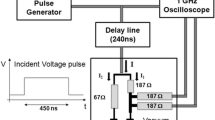Abstract
Hotspots generated in a thin-film superconductor through dissipation of Joule energy are imaged by scanning the sample with the electron beam of a scanning electron microscope equipped with a liquid He stage. The signal utilized for imaging is the change of the sample voltage caused by the beam irradiation. A theoretical analysis of the heat balance equation indicates that the voltage signal reaches a maximum at the hotspot boundaries where the temperature profile passes through the critical temperature value of the superconductor. The predictions of our theoretical model agree well with our experiments performed using films of pure Sn, O2-doped Sn, and O2-doped Al. The width of the signal peaks marking the hotspot boundaries is twice the thermal healing length of the film/substrate configuration.
Similar content being viewed by others
References
R. P. Huebener,Magnetic Flux Structures in Superconductors (Springer-Verlag, 1979).
W. J. Skocpol, M. R. Beasley, and M. Tinkham,J. Appl. Phys. 45, 4054 (1974).
R. P. Huebener,J. Appl. Phys. 46, 4982 (1975).
J. R. Clem and R. P. Huebener,J. Appl. Phys. 51, 2764 (1980).
R. Eichele, H. Seifert, and R. P. Huebener,Appl. Phys. Lett. 38, 383 (1981).
R. Eichele, R. P. Huebener, H. Pavlicek, and H. Seifert, inProceedings of the 16th International Conference on Low Temperature Physics, W. G. Clark, ed. (North-Holland, Amsterdam, 1981), Vol. II, p. 1029.
R. Eichele, R. P. Huebener, and H. Seifert,Verhandl. DPG)17, 1034 (1982).
R. Eichele, Thesis, University of Tübingen, Federal Republic of Germany (1982), unpublished.
M. Garbuny and M. Gottlieb, inHeat Flow Below 100 K and Its Technical Applications (Pergamon, New York, 1966).
G. Dharmadurai,Phys. Status Solidi A 62, 11 (1980).
W. J. Skocpol, inNonequilibrium Superconductivity, Phonons and Kapitza Boundaries, K. E. Gray, ed. (Plenum, New York, 1981), p. 559.
H. Pavlicek, L. Freytag, R. P. Huebener, and H. Seifert,Applied Superconductivity Conference, Knoxville, Tennessee (1982).
R. Eichele, W. Kern, and R. P. Huebener,Appl. Phys. 25, 95 (1981).
H. Seifert,Cryogenics 22, 657 (1982).
K. E. Gray,J. Low Temp. Phys. 23, 679 (1976).
Author information
Authors and Affiliations
Additional information
Supported by a grant from the Deutsche Forschungsgemeinschaft, by the Director for Energy Research, Office of Basic Energy Sciences, and by the NATO Research Grants Program.
Operated for the U.S. Department of Energy by Iowa State University under contract No. W-7405-Eng-82.
Rights and permissions
About this article
Cite this article
Eichele, R., Freytag, L., Seifert, H. et al. Two-dimensional imaging of hotspots in superconducting bridges by low-temperature scanning electron microscopy. J Low Temp Phys 52, 449–479 (1983). https://doi.org/10.1007/BF00682126
Received:
Issue Date:
DOI: https://doi.org/10.1007/BF00682126




